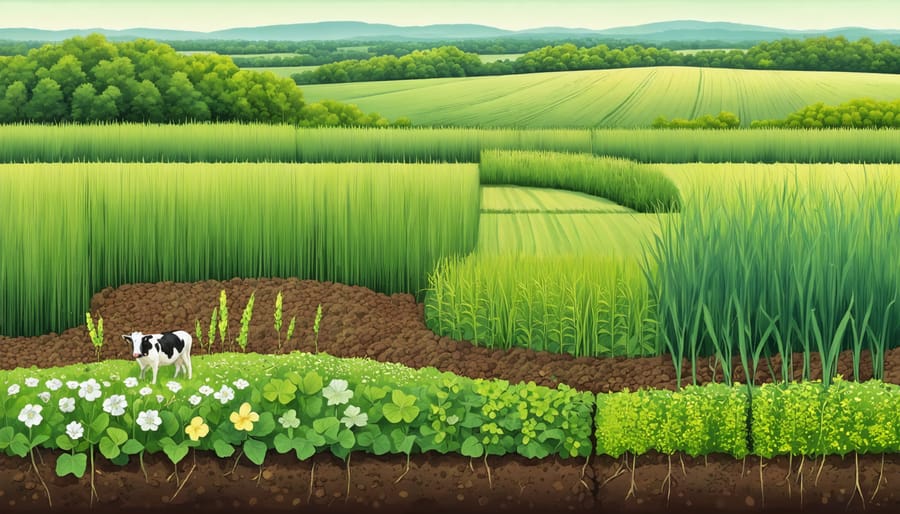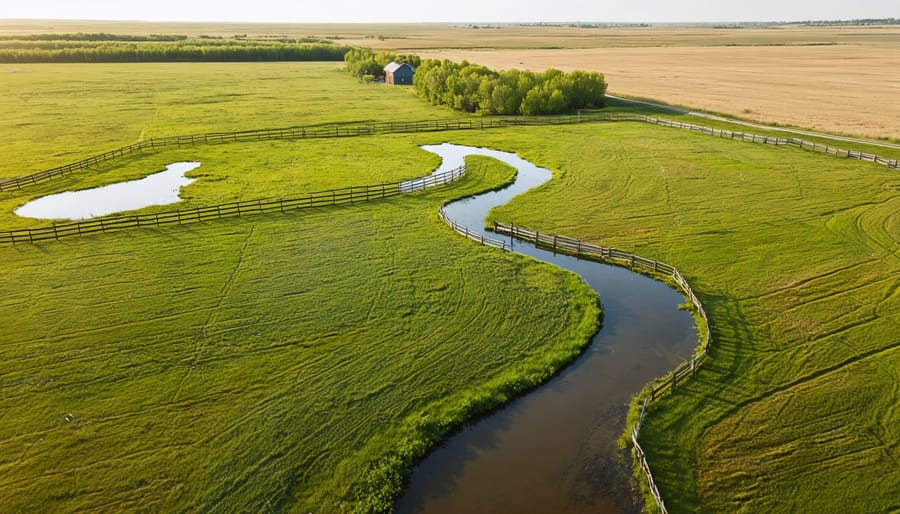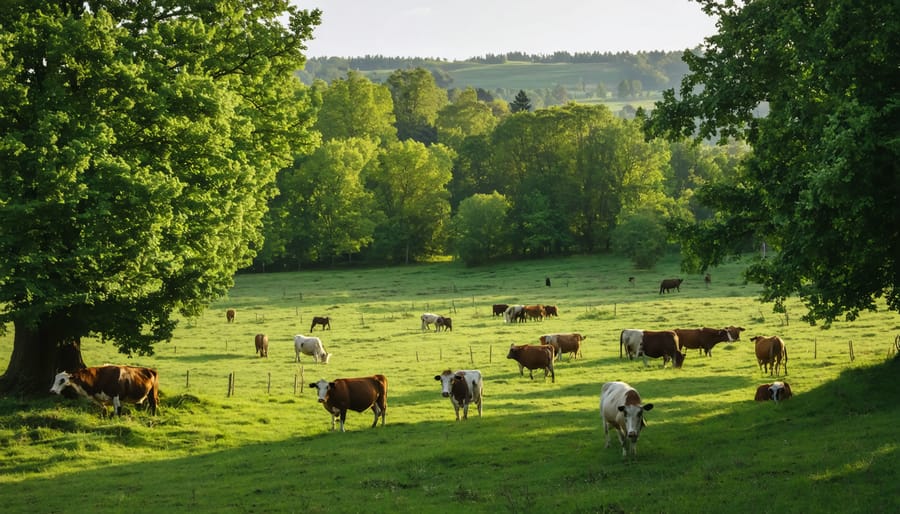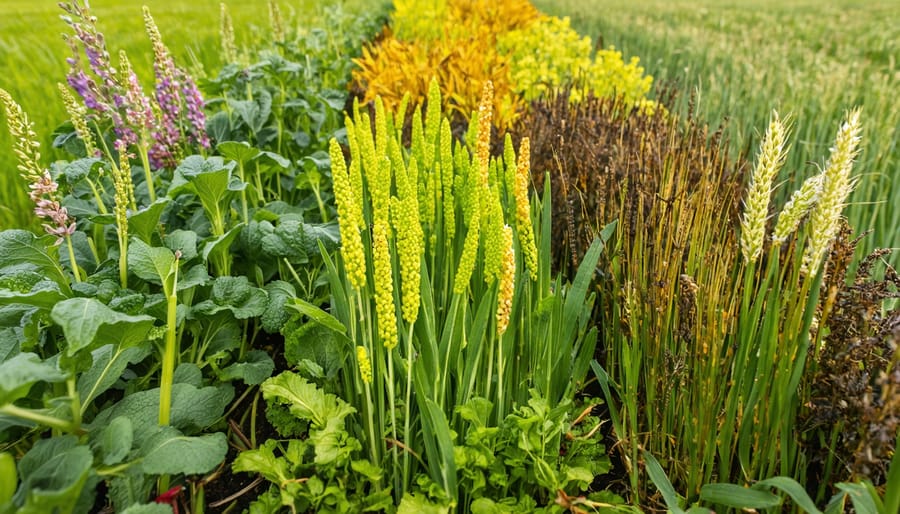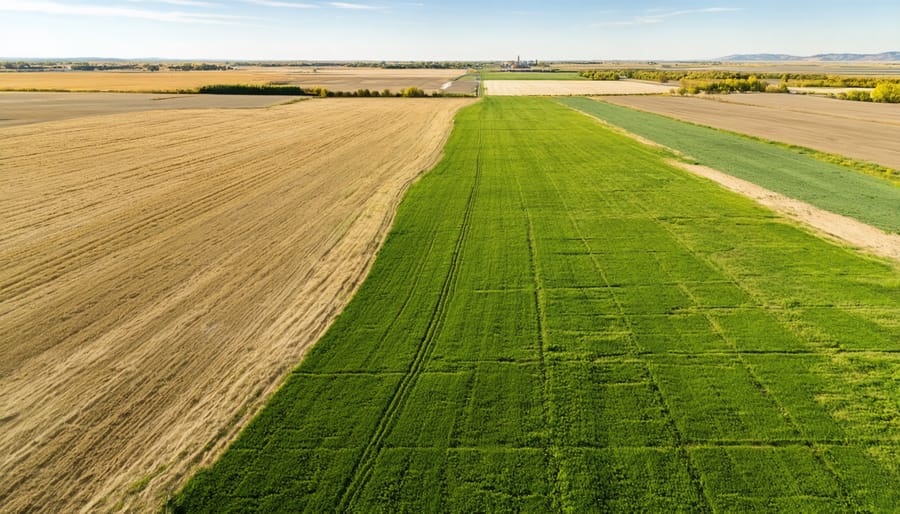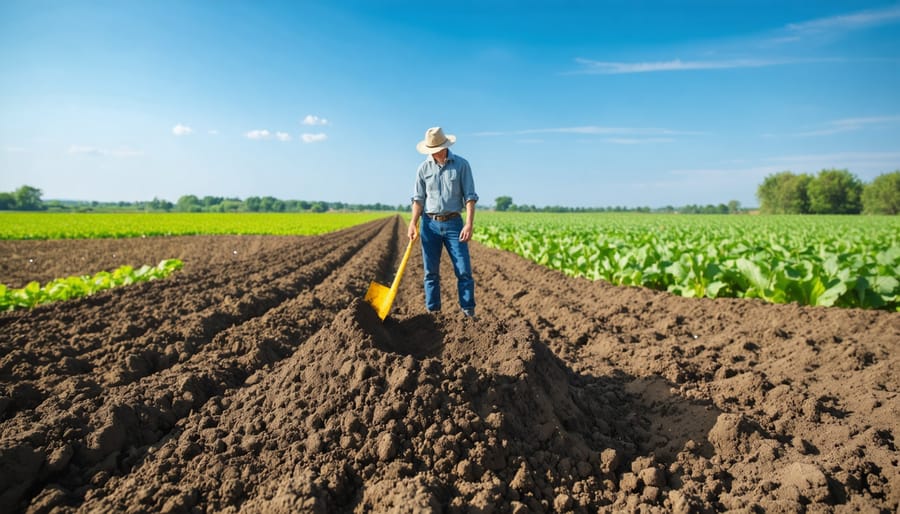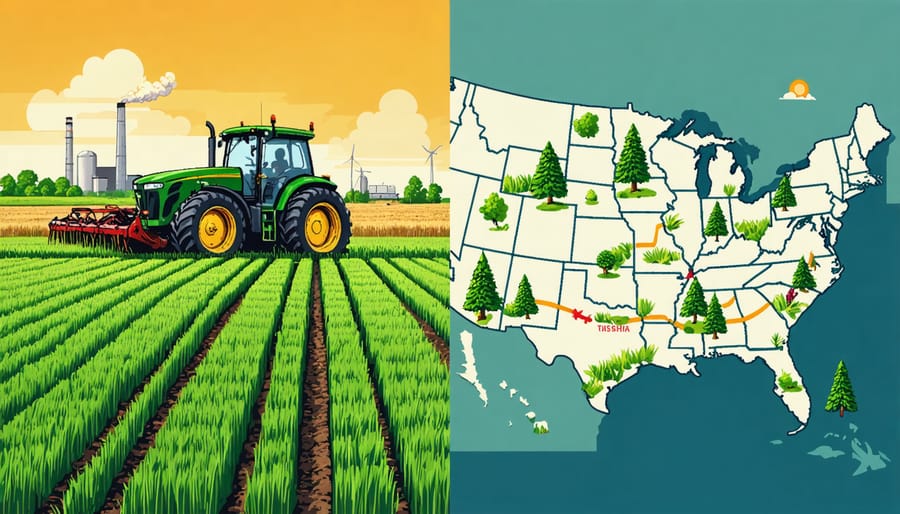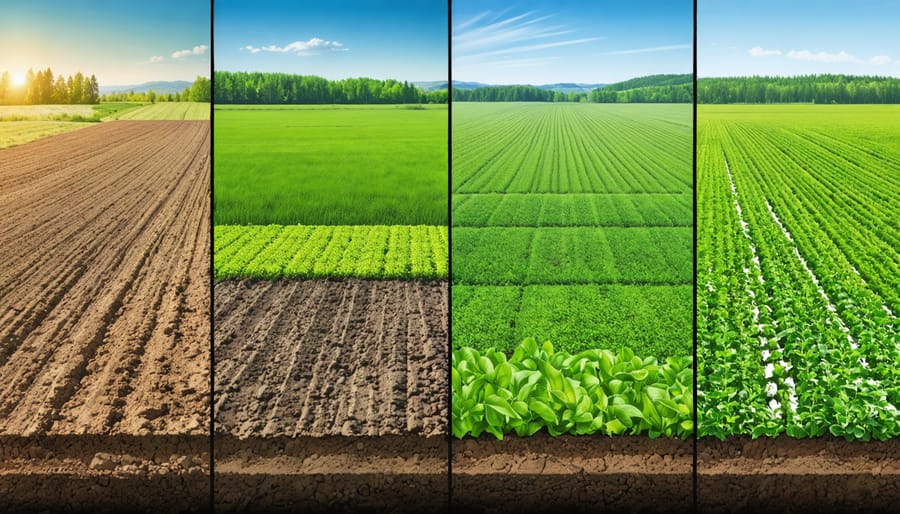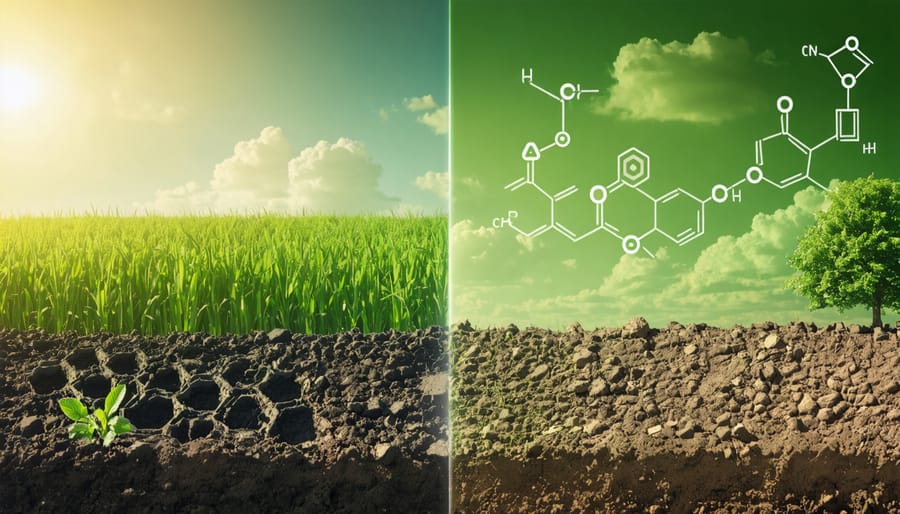Transform depleted fields into thriving ecosystems by implementing regenerative practices that restore the fundamental importance of soil health. Plant diverse cover crop mixtures featuring deep-rooted species like clover and radishes to naturally break up compaction while feeding soil microorganisms. Minimize soil disturbance through no-till methods and keep living roots in the ground year-round, building organic matter while protecting against Prairie wind erosion. Integrate livestock through managed rotational grazing to accelerate nutrient cycling and improve soil structure – a practice that’s already regenerated over 50,000 hectares of Alberta farmland. These proven techniques work together to create a self-sustaining system that builds topsoil, increases water retention, and boosts crop yields while reducing input costs. For every 1% increase in organic matter, soil can hold an additional 20,000 gallons of water per acre – a critical advantage in our drought-prone regions.
Understanding Your Soil’s Current State
Essential Soil Tests for Alberta Farms
Regular soil testing is your foundation for successful soil regeneration in Alberta. Start with these essential parameters: organic matter content, pH levels, and water infiltration capacity. Test your soil’s nitrogen, phosphorus, and potassium (NPK) levels, along with micronutrients like zinc and copper, which are often deficient in prairie soils.
Aim to test your soil every 2-3 years, ideally in spring before seeding or fall after harvest. When interpreting results, focus on trends over time rather than single readings. For Alberta soils, optimal pH typically ranges from 6.0 to 7.5, while organic matter content should be at least 3-5% in cropland.
Local soil testing labs can provide region-specific interpretations, considering our unique soil conditions and growing season. Many Alberta producers find success working with labs that understand our chinook-influenced climate and its effects on soil biology. Remember to take multiple samples across your fields, as soil conditions can vary significantly even within short distances.
Keep detailed records of your test results to track improvements and adjust your regeneration strategies accordingly.
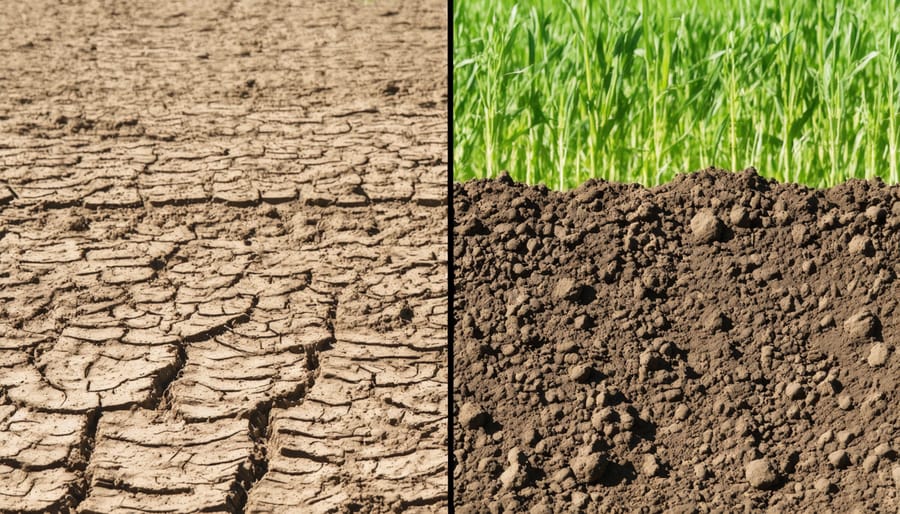
Visual Soil Assessment Techniques
Visual assessment of your soil’s health doesn’t require expensive equipment – just your eyes, hands, and a few simple tools. The shovel test is your first step: dig up a 30-centimetre cube of soil and examine its structure. Healthy soil should crumble easily and reveal a network of roots and organic matter. Look for earthworms – finding 8-10 worms per shovel full indicates good biological activity.
The jar test offers another practical insight: fill a mason jar one-third with soil, add water, shake well, and let it settle for 24 hours. The layers that form will show your soil’s composition – sand at the bottom, silt in the middle, and clay on top. Ideally, you want roughly equal proportions of each.
For a quick moisture check, grab a handful of soil and squeeze it. If it holds shape but crumbles when poked, that’s ideal. Too wet, and it’ll form a sticky ball; too dry, and it won’t hold together at all. Watch for soil colour too – darker usually means higher organic matter content, while greyish or reddish soils might signal drainage or compaction issues.
Document your findings with photos and notes each season to track improvements over time.
Core Regeneration Practices
Cover Cropping in Prairie Conditions
In Alberta’s challenging prairie climate, selecting the right cover crops is crucial for successful regenerative farming practices. Cold-hardy species like fall rye, winter triticale, and hairy vetch have proven particularly effective in our region’s short growing season and harsh winters.
For early spring planting, consider fast-growing options like oats, field peas, and mustard that can establish quickly after snowmelt. These crops provide excellent soil protection during our intense spring winds and help manage moisture levels during unpredictable rainfall periods.
Local farmers have found success with cocktail mixes that combine 3-4 species. A popular combination includes fall rye for deep root penetration, field peas for nitrogen fixation, and radish for breaking up compacted soil layers. This diversity helps maximize the benefits while spreading risk across multiple species.
Timing is critical in our climate. Plant winter-hardy varieties by mid-August to ensure adequate establishment before freeze-up. For spring plantings, aim to seed as soon as soil temperatures reach 5°C to maximize growth before summer heat stress.
Consider your termination strategy carefully. Natural winter-kill can work well for spring cereals and other frost-sensitive species, reducing the need for chemical or mechanical termination. For overwintering species, plan to terminate 2-3 weeks before seeding your cash crop to prevent moisture competition.
Remember to adjust seeding rates higher than standard recommendations, as our prairie conditions can be challenging for establishment. Start with 25% more than suggested rates and adjust based on your farm’s specific conditions and experience.
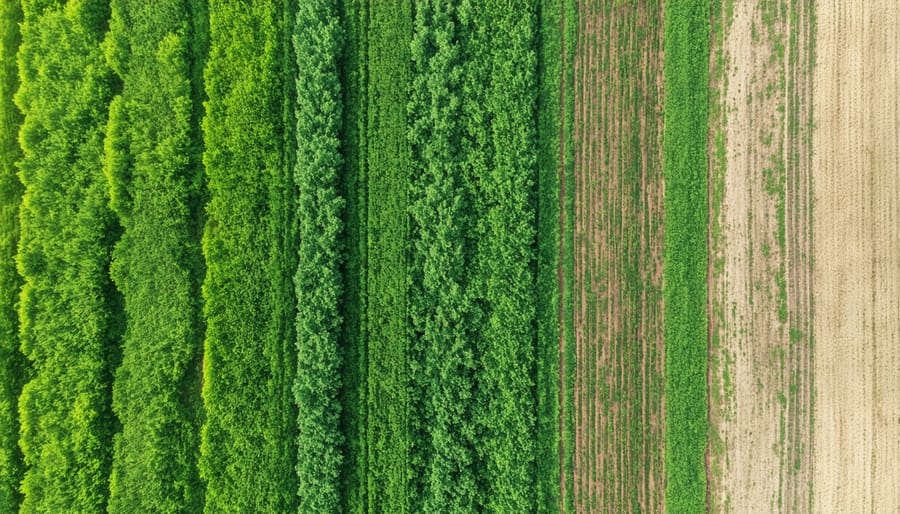
No-Till Implementation Strategies
Transitioning to benefits of no-till farming requires careful planning and patience, but the long-term rewards for soil health are substantial. Start by mapping out a three-year transition plan that gradually introduces no-till practices while maintaining crop productivity.
Begin with residue management in the first season. Leave at least 60% of crop residue on your fields after harvest to protect soil structure and feed soil organisms. Invest in proper equipment modifications or new machinery designed for no-till operations, such as disc openers and closing wheels that can handle residue effectively.
Timing is crucial for success in Alberta’s climate. Plan your seeding operations when soil temperatures reach at least 10°C and moisture conditions are optimal. Consider using cover crops during transition periods to maintain soil coverage and build organic matter. Cereal rye and field peas work particularly well in our prairie conditions.
Managing weeds becomes different, not necessarily more difficult, under no-till. Develop a diverse crop rotation plan that includes different plant families to naturally suppress weed pressure. Many successful Alberta farmers use a rotation of cereals, pulses, and oilseeds to break weed cycles effectively.
Start with your best-performing fields first, as these will be more forgiving during the transition period. Monitor soil moisture levels carefully, as no-till fields typically retain more water and may require adjusted seeding depths. Keep detailed records of your observations and results to fine-tune your approach each season.
Remember that soil biology needs time to adjust to the new system. Expect some yield variations in the first two years as your soil ecosystem rebalances itself. Connect with local farmer networks who have successfully implemented no-till practices to share experiences and solutions specific to our region.
Crop Rotation Planning
Crop rotation is a cornerstone of soil regeneration in Alberta’s diverse agricultural landscape. By strategically planning your rotation schedule, you can significantly improve soil structure, nutrient availability, and overall field health. Most successful Canadian farmers implement a 4-5 year rotation plan, which provides optimal benefits while maintaining economic viability.
Start by mapping your fields and current crop history. For Prairie conditions, a well-designed rotation typically begins with a deep-rooting crop like alfalfa or red clover, followed by a heavy feeder such as canola or wheat. Include at least one pulse crop, such as field peas or lentils, which fix nitrogen naturally and reduce fertilizer requirements for subsequent crops.
Consider incorporating cover crops between main growing seasons. Quick-growing species like fall rye or oats protect soil during Alberta’s harsh winters while adding organic matter. Many local farmers have found success with cocktail mixes of various cover crops, each serving different soil-building purposes.
When designing your rotation, remember these key principles:
– Alternate between shallow and deep-rooting crops
– Mix nitrogen-fixing legumes with heavy nitrogen users
– Include diverse crop families to break pest and disease cycles
– Plan for at least one soil-building year in every rotation cycle
Calgary-area farmer Mike Henderson shares, “Since implementing a five-year rotation including two years of cover crops, we’ve seen our organic matter increase by 2% and our water retention improve dramatically.” This experience echoes findings across the Prairie provinces, where thoughtful rotation planning has led to measurable soil improvements.
Track your rotation progress using detailed field maps and notes. Modern farm management software can help schedule rotations and monitor soil health indicators. Remember that flexibility is important – be prepared to adjust your rotation based on market conditions, weather patterns, and observed soil responses.
For best results, align your rotation schedule with other regenerative practices like reduced tillage and strategic grazing. This integrated approach maximizes the soil-building benefits while maintaining farm productivity and profitability.
Organic Matter Management
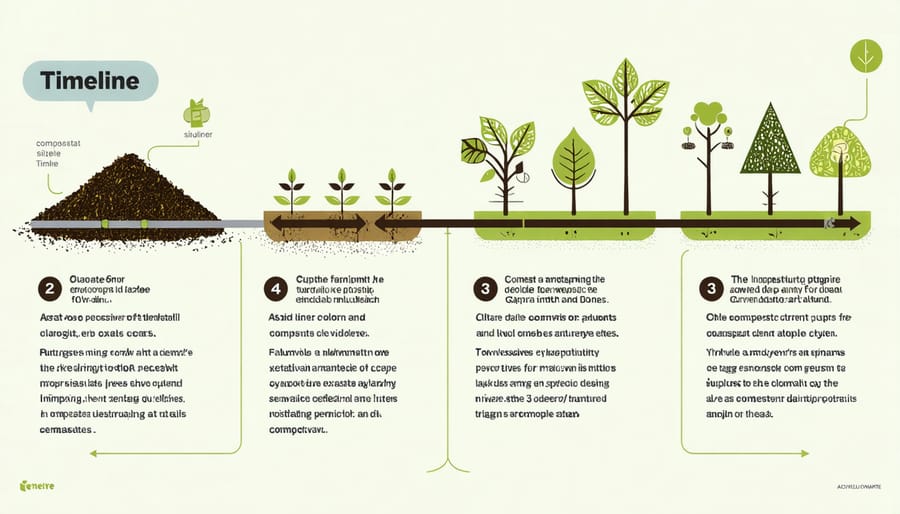
Composting for Prairie Farms
Composting at a prairie farm scale requires different approaches than backyard composting, but the principles remain the same. For large-scale farming operations, success lies in creating efficient systems that can handle substantial volumes of organic material while minimizing labor and equipment costs.
Start by designating a composting area that’s accessible year-round and protected from strong prairie winds. The site should be well-drained and at least 100 metres from water sources. Many Alberta farmers find success with windrow composting, creating rows 2-3 metres wide and 1.5 metres high for optimal decomposition.
The key to effective prairie composting is maintaining the right mix of materials. Aim for a carbon-to-nitrogen ratio of 30:1 by combining:
– Crop residues (wheat straw, canola stubble)
– Animal manure from local operations
– Green material (clippings, cover crops)
– Wood chips or sawdust (in moderation)
Temperature monitoring is crucial in our prairie climate. The pile should maintain 55-65°C in its core during the active composting phase, even during winter months. Use a long-stem thermometer to check temperatures weekly.
Many successful prairie farmers use turned windrow systems, turning the pile every 3-4 weeks during the warm season. Modern compost turners can process up to 3,000 cubic metres per hour, making this feasible for larger operations.
The finished compost should be dark, crumbly, and smell earthy. Apply it in spring or fall, using 10-15 tonnes per hectare as a starting point. Some farmers report best results when incorporating compost with shallow tillage, while others prefer surface application to minimize soil disturbance.
Remember that composting regulations vary by municipality, so check local guidelines regarding permitted materials and setback distances. Many Alberta agricultural extension offices offer composting workshops and equipment-sharing programs to help farmers get started.
Managing Crop Residues
Managing crop residues effectively is a cornerstone of soil regeneration in Alberta’s agricultural landscape. Instead of burning or removing crop remains, successful farmers across the prairie provinces have found that keeping these materials on the field provides multiple benefits for soil health and future crop success.
The key to proper residue management lies in even distribution during harvest. When combining, adjust your spreader settings to ensure stems, chaff, and other plant materials are scattered uniformly across your field width. This prevents thick mats of residue in some areas while leaving others bare, which can lead to uneven soil warming and moisture distribution in spring.
For heavy residue crops like wheat or canola, consider using a heavy harrow in early spring when the ground is still partially frozen. This technique, popular among Red Deer area farmers, helps break down tough plant materials while minimizing soil disturbance. Many producers report success with fall harrowing as well, which gives residue more time to decompose before spring seeding.
Microbial activity is crucial for breaking down crop remains. To accelerate decomposition, maintain adequate soil moisture and consider applying nitrogen at a rate of 1-2 kg per 100 kg of residue. This supplemental nitrogen helps microorganisms break down carbon-rich plant materials more efficiently without depleting soil reserves needed for the next crop.
For direct seeding operations, proper residue management begins at harvest. Using stripper headers or raising the cutting height can leave more standing stubble, which catches snow and reduces spring moisture loss while making seeding easier. Several central Alberta farmers have successfully implemented this approach, reporting improved seed placement and emergence rates.
Remember that crop residues are a valuable resource – they return organic matter and nutrients to your soil, protect against erosion, and help maintain soil moisture. By treating them as an asset rather than a nuisance, you’re investing in your soil’s long-term productivity and health.
Soil Biology Enhancement
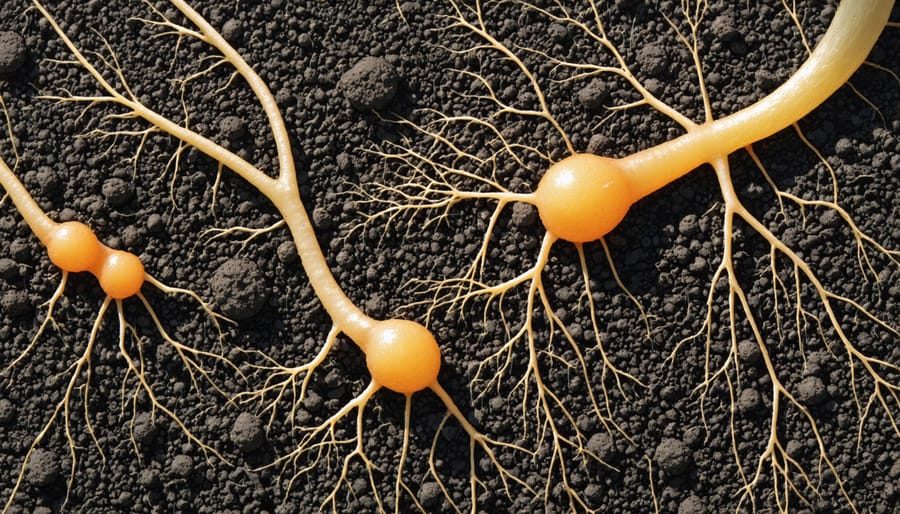
Building the Soil Food Web
The soil food web is your underground workforce, comprising billions of beneficial organisms that work together to build healthy soil. In Alberta’s agricultural landscape, fostering these relationships is crucial for sustainable farming success. Start by minimizing tillage, which disrupts fungal networks and soil structure. Instead, maintain continuous living roots through cover cropping and diverse crop rotations to feed your soil organisms year-round.
Adding organic matter through compost, manure, or crop residues provides food for bacteria and fungi, which in turn support larger organisms like earthworms and beneficial nematodes. Many Prairie farmers have found success using composted cattle manure, reporting improved soil structure within just two growing seasons.
Avoid broad-spectrum pesticides and fungicides when possible, as these can harm beneficial organisms. Consider inoculating your soil with mycorrhizal fungi, particularly when establishing new crops. These fungi form essential partnerships with plant roots, improving nutrient uptake and water efficiency.
Maintain soil moisture through mulching and proper irrigation practices – soil organisms need adequate moisture to thrive. Consider implementing buffer strips or hedgerows to create permanent habitat zones for beneficial insects and microorganisms.
Remember, building the soil food web takes time. Calgary-area farmer Mike Thompson notes, “After three years of focused soil building, we’ve seen earthworm populations triple and noticed significantly better water retention in our fields.” Start with small test plots to observe what works best for your specific conditions.
Using Bio-amendments
Bio-amendments are living solutions for improving soil health, and they’re becoming increasingly popular among Alberta farmers. These biological enhancers include compost tea, beneficial microorganisms, and mycorrhizal fungi that work together to boost soil fertility naturally.
When selecting bio-amendments, start with locally sourced compost, which typically contains microorganisms already adapted to our climate. Many Prairie farmers have found success using vermicompost, which introduces beneficial earthworm castings and associated microbes. For best results, apply compost at 2-5 tonnes per hectare during spring preparation or fall cleanup.
Microbial inoculants can jumpstart soil biology, especially in fields transitioning from conventional farming. Look for products containing diverse bacterial and fungal species, and apply them when soil temperatures reach at least 10°C for optimal colonization. Consider combining these with humic substances, which provide a stable home for microorganisms while improving soil structure.
Manitoba farmer Dave Robertson shares, “After three years of using bio-amendments, we’ve seen a 30% increase in organic matter and significantly better water retention in our fields.” To maximize effectiveness, apply bio-amendments when soil moisture levels are adequate, typically early morning or evening to protect beneficial organisms from harsh sunlight.
Remember to monitor your soil’s response through regular testing and visual assessment of plant health. Start with small test plots to determine which amendments work best for your specific soil conditions and crop rotation.
Regenerating soil health is a journey that requires dedication, patience, and a commitment to sustainable farming practices. As we’ve explored throughout this guide, the path to healthy soil begins with thorough assessment and thoughtful implementation of various techniques, from cover cropping to reduced tillage. Here in Alberta, we’ve seen remarkable transformations on farms that have embraced these methods, with many reporting improved yields and reduced input costs within just a few growing seasons.
Remember, you don’t need to implement every strategy at once. Start with what works best for your operation and gradually expand your regenerative practices. Consider connecting with local agricultural extension services and fellow farmers who are already on this journey – their experiences and insights can be invaluable.
The future of Canadian agriculture depends on our soil health. By taking steps today to regenerate our soil, we’re not just improving our farms; we’re building a more resilient and sustainable agricultural system for generations to come. Whether you’re managing a large-scale operation or a smaller farm, every effort towards soil regeneration contributes to the broader goal of maintaining Canada’s agricultural heritage while embracing innovative, earth-friendly farming practices.

